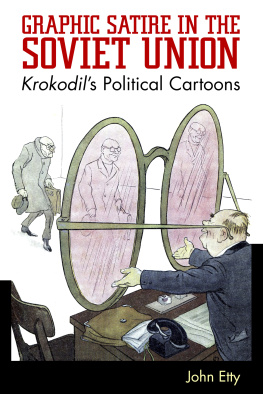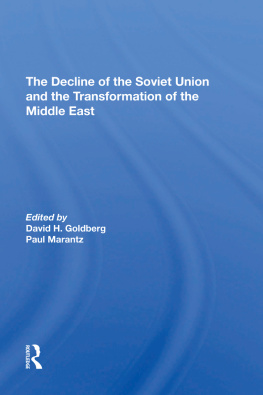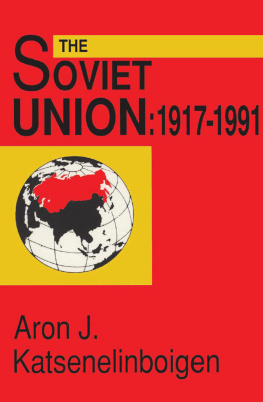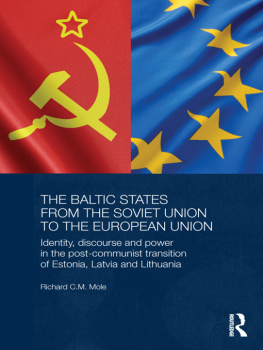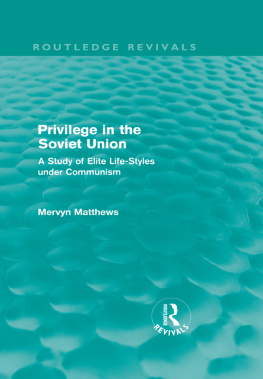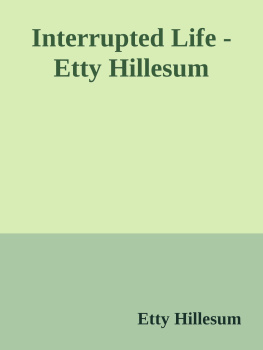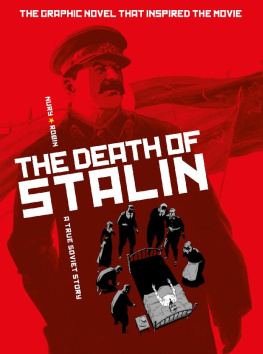Etty - Graphic Satire in the Soviet Union
Here you can read online Etty - Graphic Satire in the Soviet Union full text of the book (entire story) in english for free. Download pdf and epub, get meaning, cover and reviews about this ebook. year: 2018, publisher: University Press of Mississippi, genre: Politics. Description of the work, (preface) as well as reviews are available. Best literature library LitArk.com created for fans of good reading and offers a wide selection of genres:
Romance novel
Science fiction
Adventure
Detective
Science
History
Home and family
Prose
Art
Politics
Computer
Non-fiction
Religion
Business
Children
Humor
Choose a favorite category and find really read worthwhile books. Enjoy immersion in the world of imagination, feel the emotions of the characters or learn something new for yourself, make an fascinating discovery.
Graphic Satire in the Soviet Union: summary, description and annotation
We offer to read an annotation, description, summary or preface (depends on what the author of the book "Graphic Satire in the Soviet Union" wrote himself). If you haven't found the necessary information about the book — write in the comments, we will try to find it.
Etty: author's other books
Who wrote Graphic Satire in the Soviet Union? Find out the surname, the name of the author of the book and a list of all author's works by series.
Graphic Satire in the Soviet Union — read online for free the complete book (whole text) full work
Below is the text of the book, divided by pages. System saving the place of the last page read, allows you to conveniently read the book "Graphic Satire in the Soviet Union" online for free, without having to search again every time where you left off. Put a bookmark, and you can go to the page where you finished reading at any time.
Font size:
Interval:
Bookmark:

GRAPHIC SATIRE IN THE
SOVIET UNION
GRAPHIC SATIRE IN THE SOVIET UNION
Krokodils Political Cartoons
John Etty
University Press of Mississippi / Jackson
Publication of this book was made possible, in part, by a grant from the First Book Subvention Program of the Association for Slavic, East European, and Eurasian Studies.
The University Press of Mississippi is the scholarly publishing agency of the Mississippi Institutions of Higher Learning: Alcorn State University, Delta State University, Jackson State University, Mississippi State University, Mississippi University for Women, Mississippi Valley State University, University of Mississippi, and University of Southern Mississippi.
www.upress.state.ms.us
The University Press of Mississippi is a member of the Association of University Presses.
Copyright 2019 by University Press of Mississippi
All rights reserved
Manufactured in the United States of America
First printing 2019
Library of Congress Cataloging-in-Publication Data
Names: Etty, John, 1979 author.
Title: Graphic satire in the Soviet Union : Krokodils political cartoons / John Etty.
Description: Jackson : University Press of Mississippi, [2019] | Includes bibliographical references and index. |
Identifiers: LCCN 2018025167 (print) | LCCN 2018029399 (ebook) | ISBN 9781496820532 (epub single) | ISBN 9781496820549 (epub institutional) | ISBN 9781496820556 (pdf single) | ISBN 9781496820563 (pdf institutional) | ISBN 9781496820525 (hardcover : alk. paper) | ISBN 9781496821089 (pbk. : alk. paper)
Subjects: LCSH: Krokodil. | Political satire, Russian20th centuryHistory and criticism. | Soviet UnionPolitics and governmentCaricatures and cartoons. | Russian wit and humor, Pictorial.
Classification: LCC NC1578.K7 (ebook) | LCC NC1578.K7 E88 2019 (print) | DDC 741.5/6947dc23
LC record available at https://lccn.loc.gov/2018025167
British Library Cataloging-in-Publication Data available
CONTENTS
ACKNOWLEDGMENTS
Many people supported me in the writing of this book. The greatest debt is to Vlad Strukov, whose inspirational advice and encouragement saw me through years of research and writing. Paul Cookes assistance was precise and reassuring, and his feedback on numerous drafts shaped the way I saw my work. Sarah Hudspith and Mike OMahoney also provided generous encouragement. My panel colleagues at the ASEEES Convention in Boston in 2013, Annie Grin and Stephen M. Norris, both provided motivation without realizing. Our discussant, Helena Goscilo, was as entertaining and encouraging as she was insightfully critical in her commentary, and she has continued to provide guidance ever since. Thanks also to Jonathan Waterlow, Simon Huxtable, Maria Popova, Tim OConnor, Barbara McGowan, Svetlana Loukine, and Nellie and Doug Paul. Dima Frangulov granted me access to the database of digitized copies of Krokodil, which allowed me to broaden the scope of my analysis.
Thanks also go to my parents and my sister, whose examples I continue to follow, for their help and encouragement. Most of all, Kim has been a constant and patient supporter: her belief made me brave enough. Finally, this book is for Ivy and Sam: may it somehow enrich your lives, as it has done mine.
GRAPHIC SATIRE IN THE
SOVIET UNION
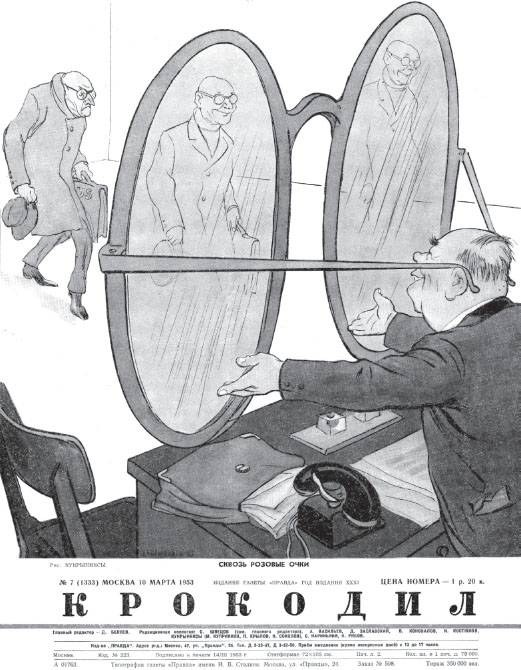
I.1. Kukryniksy. Through rose-colored spectacles (Skvoz rozovye ochki). Krokodil 1953: 7/16.
INTRODUCTION
The back page of Krokodil no. 7, 1953 (the first issue published after Josef Stalins death), features a cartoon warning against naivete, trustfulness, and overeagerness to forget the past (see ). Coming after six pages of tributes to Stalin, this image visualizes a bureaucrat welcoming a visitor into his office. As readers, we enjoy a privileged gaze; we appreciate the effect of a giant pair of rose-colored spectacles, while retaining our unimpeded vision of the scene. The figure approaching the desk appears either friendly or sinister, depending on which view we opt to take. As was typical of the magazines style, especially under the editorship of Dmitrii Beliaev (19481953), a degree of naturalism in the rose-tinted view is contrasted with a more grotesque image, to provide instruction on how to interpret the cartoon.
For regular readers of Krokodil, this image would have seemed familiar. Binary compositions, juxtaposing representatives of opposing ideologies, frequently feature in Stalin-era poster and cartoon art. Opposing pairs of ideasus/them, good/evil, communism/capitalism, now/then, here/there, either/or contrastswere staples in the visual language of Stalinism (Bird, Heuer, Jackson, Mosaka and Smith 2011: 25). This visitor, who wears swastika spectacles and carries a briefcase embossed with US, is constructed in graphic terms that echo the discourses of cosmopolitanism in the postwar Stalin years, as well as those invoking Soviet patriotism in the 1930s, and the Nazification of the US that occurred in postwar Soviet graphic satire. His hunched shoulders, stooping gait, pallid skin, and unsmiling countenance contrast dramatically with the benevolent figures seen through the rose-tinted lenses. Ostensibly, echoing Stalinist rhetoric, this cartoon employs the glasses as a visual metaphor for ideological illusions or lack of vigilance: looking through rose-tinted spectacles blinds us to potential dangers. The glasses form the figurative and compositional center of the image, apparently dividing the image of the old man in two. The cartoon thus functions as a lesson in seeing and the power of ideology to act as a barrier to true recognition.
Like many cartoons published in Krokodil, this image, didactic and monologic though it seems, warrants more careful consideration. Rather than a binary visioncontrasting obstructed and unobstructed viewsthis cartoon presents three different versions of the old man. As if constructing a critique of Stalinisms binarism, and preceding the pluralism that distinguished the post-Stalin era, this cartoon multiplies the visions of its object. Moreover, in doing so it draws attention to its own act of doubling. The two lenses offer different views of the visitors spectacles, smile, head angle, and clothing folds. We expect spectacles to correct or improve our vision, but these pink lenses distort. The cartoon thus creates and disrupts our understanding of this binary view: bi-ocularism multiplies and complicates.
The Kukryniksy collective, producers of this cartoon, frequently jointly created images, but the discrepancies are not the results of poor technique. The Chinese cartoonist Jack Chen, who knew many Soviet cartoonists, noted that the trios caricature of him was perfect though they drew me from three separate corners of the room [and it was] impossible to say where ones line ended and anothers began (Chen 1944: 38).1 Skepticism about the veracity of appearances and the importance of mastery of ones own vision are recommended by this image. Here, Krokodil presents seeing as a habit to be learnedMichel Foucault calls such practices technologies of the self (1988: 18)and, furthermore, one through which individuals may perform their own psychological shifts. Krokodil cartoons suggest that satirical vision might be considered one such technology or technique for altering the self. As this book argues, Krokodil repeatedly performed seeing for its readers benefit. Its satire taught a kind of X-ray vision, and was a thinking tool for rationalizing divergences between rhetoric and visual experience. While cautioning against naivete, this cartoon also interrogates the power of images, offering alternative visions.
Next pageFont size:
Interval:
Bookmark:
Similar books «Graphic Satire in the Soviet Union»
Look at similar books to Graphic Satire in the Soviet Union. We have selected literature similar in name and meaning in the hope of providing readers with more options to find new, interesting, not yet read works.
Discussion, reviews of the book Graphic Satire in the Soviet Union and just readers' own opinions. Leave your comments, write what you think about the work, its meaning or the main characters. Specify what exactly you liked and what you didn't like, and why you think so.

